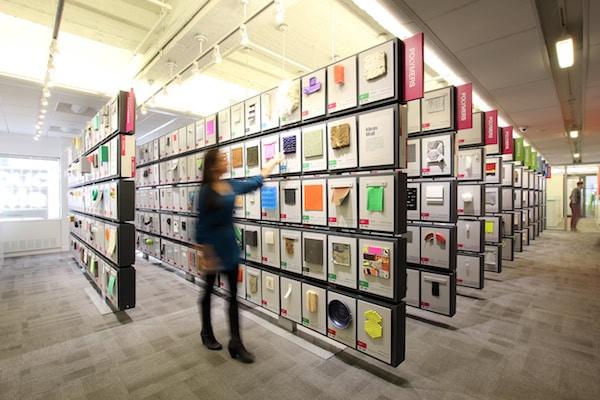
[Image above] Credit: Materials ConneXion
There’s a library on the 17th floor of a building near Rockefeller Center in New York City—but you won’t find a copy of War and Peace anywhere in the place. Instead, you’ll find things like conductive glass… and translucent cement… and aluminum foam.
Intrigued? I thought you might be…
It’s Material ConneXion, one of the largest subscription-based materials libraries on the globe, with about 7,500 innovative materials and processes in their database that spans a wide range of disciplines and industries focused on bridging the gap between science and design. They have more than a million active members from Fortune 500 companies, forward-thinking agencies, and areas of government in search cultivating a creative, competitive, or sustainable edge in their respective industries.
The New York location is home to about 2,500 materials on exhibition for clients. And forget the “see with your eyes, not with your hands” policy. Founded in 1997 by George Beylerian, he originally called Materials ConneXion “a ‘petting zoo’ for new materials as a resource for architects and designers.” From the beginning, visitors have been encouraged to poke, pull, and grab any materials on display.

The Ideas Wall at Materials ConneXion in New York City where clients can get inspiration from examining materials like leather made from cow innards and floor tiles made from snail excrement. Credit: Materials ConneXion
And the already-impressive collection is growing all the time. Materials are selected through a strict review process, and 40+ new materials are independently juried into the library every month.
In a 2012 video from The Economist, Andrew Dent, vice president, library and materials research at Materials ConneXion, shares his vision for the future of materials science.
https://www.youtube.com/watch?v=DUYL7nQVCh4
Credit: The Economist; YouTube
“I feel that if we could class the 20th century as a ‘synthetic century,’ where we spent all of our energy and resources in manufacturing synthetic materials, I think… or I hope… the 21st century will be a ‘biological century.’ We finally understand nature more effectively, and if we can use it effectively, it will allow us to create new materials, which will require less resources, less energy, and are just more complexly produced,” Dent says in the video.
On such material you’ll see in the library is a perfect example of how nature can be used effectively. It’s from Ecovative, a material science company developing a new class of home-compostable bioplastics based on fingal mycelium, a living organism, called Mushroom® Materials.

Credit: Ecovative; YouTube
The road to engineering new materials by design is complex, but researchers and scientists can always look to Mother Nature for inspiration. From developing synthetic spider silk, to cultivating new ways to offer cleaner, greener, and reusable rare earth elements, there certainly isn’t a lack of innovation in the materials science world.
How do you think partnering with nature and bridging the gap between science and design will change how we create and use new materials in the future? Tell us your thoughts in the comments!
Author
Stephanie Liverani
CTT Categories
- Environment
- Manufacturing
- Material Innovations
- Weekly Column: “Other materials”

